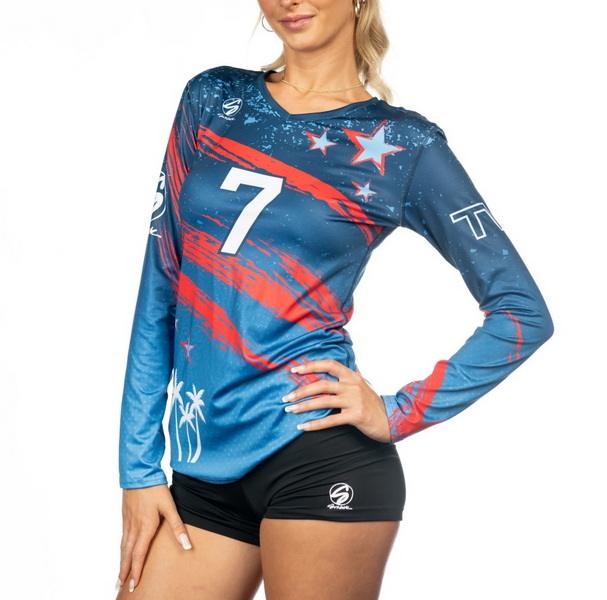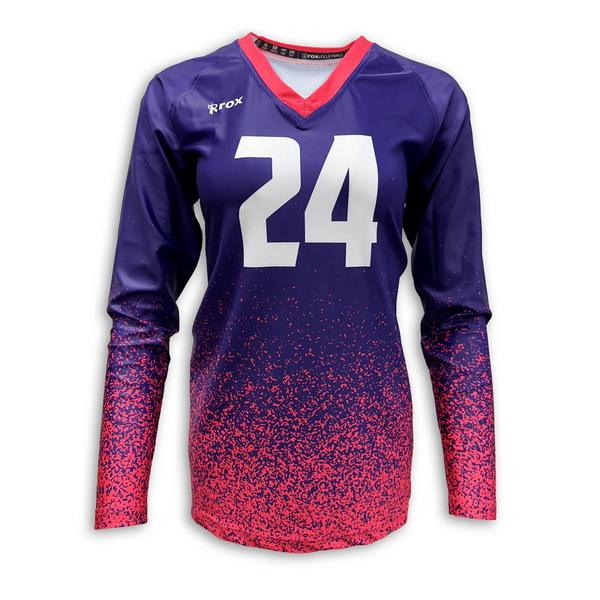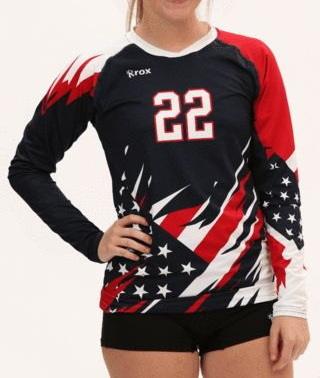Content Menu
● What Are Sublimated Volleyball Jerseys?
● The Eco-Friendly Edge of Sublimated Volleyball Jerseys
>> Sustainable Materials: Recycled Polyester
>> Waste Reduction and Water Conservation
>> Eco-Friendly Packaging and Supply Chain Practices
● Technical Advantages of Sublimated Volleyball Jerseys
>> Customization and Brand Identity
● Supply Chain Insights: Manufacturing and Delivery
>> Leading Manufacturers and Quality Control
>> Global Production and Export Trends
>> Sustainability Certifications and Compliance
● Product Development Expertise: Designing for Sustainability and Performance
● Innovations in Sustainable Fabric Technology
● The Role of Supply Chain Transparency
● The Impact of Sustainable Jerseys on Team Branding
● Challenges and Future Directions
● Collaborations and Industry Initiatives
● FAQ
>> 1. What materials are used in sustainable sublimated volleyball jerseys?
>> 2. How does sublimation printing contribute to sustainability?
>> 3. Are sublimated volleyball jerseys durable for intense play?
>> 4. Can sublimated volleyball jerseys be customized?
>> 5. What certifications should I look for in a sustainable volleyball jersey manufacturer?
Volleyball jerseys are more than just team apparel—they are a blend of performance technology, style, and increasingly, sustainability. As the sports industry embraces eco-conscious manufacturing, sublimated volleyball jerseys have emerged as a leading solution that combines vibrant customization with environmentally responsible production. This article explores the technical aspects, supply chain insights, and product development expertise behind sustainable sublimated volleyball jerseys, illustrating why they are the optimal choice for teams committed to performance and planet-friendly practices.

What Are Sublimated Volleyball Jerseys?
Sublimated volleyball jerseys are crafted using a dye sublimation printing process where the ink is converted from solid to gas and then infused directly into the polyester fabric fibers under heat and pressure. Unlike traditional screen printing or heat transfers that sit on top of the fabric, sublimation embeds the design into the material itself. This results in vivid, durable colors that do not fade, peel, or crack over time.
The fabric used is typically 100% polyester or polyester blends, chosen for their moisture-wicking properties and durability. Cotton is avoided as it does not hold sublimation inks well and lacks performance qualities such as quick drying and sweat management.
The Eco-Friendly Edge of Sublimated Volleyball Jerseys
Sustainable Materials: Recycled Polyester
A core component of sustainable sublimated volleyball jerseys is the use of recycled polyester (rPET), which is produced by melting down and re-spinning plastic waste such as PET bottles into new fibers. This process conserves petroleum resources, reduces plastic pollution, and significantly lowers carbon emissions and water usage compared to virgin polyester production.
Recycled polyester maintains the same performance characteristics as virgin polyester, including moisture-wicking, durability, and colorfastness, making it ideal for high-performance sportswear like volleyball jerseys.
Waste Reduction and Water Conservation
Sublimation printing itself is a highly sustainable manufacturing method. It generates minimal waste because the ink is directly infused into the fabric, eliminating excess dye runoff and reducing water consumption drastically compared to traditional dyeing and printing methods.
Moreover, sublimation allows for on-demand production, which minimizes overstock and reduces the environmental impact associated with unsold inventory.
Eco-Friendly Packaging and Supply Chain Practices
Leading manufacturers incorporate biodegradable or compostable packaging materials such as PLA (polylactic acid) derived from renewable sources like corn starch to further reduce plastic waste. Additionally, many suppliers maintain certifications such as ISO 14001 for environmental management, ensuring continuous improvement in sustainability practices throughout their supply chains.
Technical Advantages of Sublimated Volleyball Jerseys
Durability and Longevity
Because the design is part of the fabric, sublimated jerseys withstand repeated washing and intense physical activity without degradation of colors or logos. This longevity reduces the need for frequent replacements, contributing to less textile waste over time.
Comfort and Performance
Sublimated jerseys are lightweight and breathable, with no additional layers of ink or embellishments that could cause chafing or restrict movement. The polyester and polyester-spandex blends provide excellent stretch and recovery, allowing players to perform agile movements such as jumping, diving, and quick directional changes with ease.
Customization and Brand Identity
Sublimation offers virtually unlimited design possibilities, enabling teams to incorporate complex graphics, gradients, and multiple colors without extra cost. This flexibility helps teams express their unique identity and fosters unity on the court.
Supply Chain Insights: Manufacturing and Delivery
Leading Manufacturers and Quality Control
Top volleyball jersey manufacturers, especially those specializing in sublimation, operate vertically integrated factories with in-house design and production teams. This integration ensures strict quality control, fast turnaround times, and the ability to customize orders with low minimum quantities.
Advanced printing equipment such as Japan Epson inkjet printers and Italian MonTi transfer printers are commonly used to achieve high-resolution, vibrant prints with consistent quality.
Global Production and Export Trends
Countries like Pakistan, Vietnam, and India dominate global exports of volleyball jerseys, accounting for a significant share of shipments worldwide. The United States, Bhutan, and the Philippines are major importers, reflecting a robust international demand for high-quality, customizable volleyball apparel.
Sustainability Certifications and Compliance
Manufacturers with ISO 9001 and ISO 14001 certifications demonstrate adherence to quality management and environmental standards. Compliance with social responsibility initiatives ensures ethical labor practices alongside environmental stewardship.
Product Development Expertise: Designing for Sustainability and Performance
Material Selection
Expert product developers prioritize fabrics that balance sustainability with athletic performance. Recycled polyester blends with spandex provide the necessary stretch, durability, and moisture management needed for volleyball jerseys.
Printing Technology
Dye sublimation is favored not only for its environmental benefits but also for its ability to produce sharp, vibrant graphics that last. This technology supports intricate team logos and player personalization without compromising fabric breathability or comfort.
Fit and Functionality
Designers incorporate mesh panels and ergonomic cuts to enhance ventilation and freedom of movement. Seamless or flatlock stitching techniques reduce chafing, improving athlete comfort during long matches.
Lifecycle Considerations
Sustainable product development includes planning for jersey longevity, repairability, and end-of-life recycling programs. Some brands offer take-back initiatives to recycle old jerseys into new materials, closing the loop in the product lifecycle.

Innovations in Sustainable Fabric Technology
Recent advancements in textile technology have introduced bio-based polyester alternatives derived from renewable resources such as corn and sugarcane. These bio-polyesters offer similar performance benefits to traditional polyester but with a significantly reduced carbon footprint. Incorporating these materials into volleyball jerseys further enhances their sustainability credentials.
Additionally, innovations in fabric finishes now allow for antimicrobial and odor-resistant properties without harmful chemicals, improving athlete hygiene and reducing the frequency of washing, which in turn conserves water and energy.
The Role of Supply Chain Transparency
Transparency in the supply chain is becoming a critical factor for teams and organizations committed to sustainability. Manufacturers are increasingly adopting blockchain and digital tracking technologies to provide verifiable information about the origin of materials, production processes, and labor conditions. This transparency builds trust with consumers and supports ethical purchasing decisions.
By tracing the entire lifecycle of a volleyball jersey—from raw material sourcing to final delivery—teams can confidently promote their commitment to sustainability and social responsibility, which resonates strongly with modern consumers and sponsors.
The Impact of Sustainable Jerseys on Team Branding
Sustainable sublimated volleyball jerseys not only benefit the environment but also positively influence team branding and fan engagement. Teams that prioritize eco-friendly apparel can leverage this commitment in marketing campaigns, attracting environmentally conscious fans and sponsors. This alignment with sustainability values can enhance team reputation and open new revenue streams.
Moreover, eco-friendly jerseys often become a symbol of innovation and leadership within sports communities, helping teams stand out in a crowded marketplace and fostering stronger emotional connections with supporters.
Challenges and Future Directions
Despite the benefits, challenges remain in scaling sustainable manufacturing practices. The cost of recycled and bio-based materials can be higher than conventional options, and supply chain disruptions may affect availability. However, ongoing research and increased demand are driving innovations that promise to lower costs and improve accessibility.
Future directions include integrating smart textiles with sustainability, such as fabrics that monitor player performance or adapt to environmental conditions while maintaining eco-friendly production standards. The development of biodegradable or fully recyclable volleyball jerseys is also underway, aiming to further reduce environmental impact at the end of the product lifecycle.
Collaborations and Industry Initiatives
Industry collaborations and initiatives play a vital role in advancing sustainable sportswear. Organizations like the Sustainable Apparel Coalition and bluesign® provide frameworks and certifications that help manufacturers meet environmental and social standards. Partnerships between brands, suppliers, and environmental groups foster innovation and accelerate the adoption of sustainable practices across the volleyball apparel industry.
These collaborations also facilitate knowledge sharing and investment in new technologies, ensuring that sustainability becomes a core pillar of volleyball jersey manufacturing rather than a niche offering.
Conclusion
Sustainable sublimated volleyball jerseys represent the pinnacle of eco-friendly sports apparel manufacturing. By combining recycled materials, waste-reducing sublimation printing, and advanced design techniques, these jerseys deliver unmatched durability, comfort, and customization while minimizing environmental impact. Teams that choose sublimated volleyball jerseys not only enhance their performance and brand identity but also contribute to a healthier planet.
Are you ready to elevate your volleyball team’s look and sustainability? Contact us today to explore custom sublimated volleyball jersey options tailored to your team’s unique style and eco-conscious values. Let’s work together to make your team stand out on the court and support environmental responsibility.

FAQ
1. What materials are used in sustainable sublimated volleyball jerseys?
Sustainable sublimated volleyball jerseys primarily use recycled polyester (rPET) fabrics, often blended with spandex for stretch. These materials offer moisture-wicking, durability, and eco-friendly benefits by repurposing plastic waste.
2. How does sublimation printing contribute to sustainability?
Sublimation printing infuses ink directly into fabric fibers, producing minimal waste and requiring little to no water compared to traditional dyeing. This process reduces environmental pollution and supports on-demand production to avoid overstock.
3. Are sublimated volleyball jerseys durable for intense play?
Yes, sublimated jerseys are highly durable. The embedded designs resist fading, cracking, or peeling even after multiple washes and rigorous gameplay, making them ideal for volleyball’s physical demands.
4. Can sublimated volleyball jerseys be customized?
Absolutely. Sublimation allows for unlimited color options and complex designs without extra cost. Teams can personalize jerseys with logos, player names, and numbers to create unique, professional uniforms.
5. What certifications should I look for in a sustainable volleyball jersey manufacturer?
Look for manufacturers with ISO 14001 environmental management certification and ISO 9001 quality management certification. These indicate adherence to environmental standards and consistent product quality. Additionally, social compliance certifications ensure ethical labor practices.
Hot Tags:
Sublimated Volleyball Jerseys, Custom Volleyball Uniforms, Volleyball Team Jerseys, Sublimation Vs Screen Print, Best Volleyball Jerseys, High-Performance Volleyball Jerseys, Lightweight Team Jerseys, Custom Athletic Apparel, Volleyball Jersey Printing, Modern Team Uniforms
